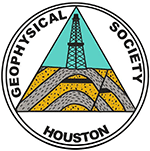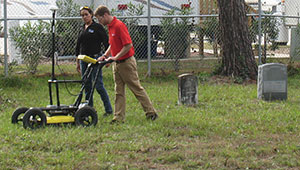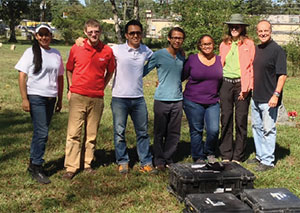Wavelets - Probing the Past: Subsurface Imaging to Identify Burials at the Mueschke
Cemetery, Houston
Wavelets Article in April GSH Journal
NOTE: This project was the subject of the American Geophysical Union’s GeoSpace blog on Dec. 17, 2014.
By Azie Aziz and Robert Stewart
 While many geophysics students are enthusiastically investigating ways to find the
next massive petroleum deposit, others have turned their attention to shallower targets.
The Allied Geophysical Lab has partnered with Lone Star College- North Harris to collaboratively
search for unmarked graves at the Mueschke Cemetery in northwest Houston. The project
was motivated by the need to preserve and further document this historic cemetery.
The effort is supported by the Mueschke Cemetery Association. The Cemetery is the
final resting place for several notable Texas residents like Mueschke, Tautenhahn,
West, Fussell, and Pennington. Veterans buried there are known to have served in the
American Civil War, Spanish-American War, and World Wars I and II. The oldest known,
but as yet un-located, grave is that of James R. West, who passed away in 1875 - we
aspire to find it.
While many geophysics students are enthusiastically investigating ways to find the
next massive petroleum deposit, others have turned their attention to shallower targets.
The Allied Geophysical Lab has partnered with Lone Star College- North Harris to collaboratively
search for unmarked graves at the Mueschke Cemetery in northwest Houston. The project
was motivated by the need to preserve and further document this historic cemetery.
The effort is supported by the Mueschke Cemetery Association. The Cemetery is the
final resting place for several notable Texas residents like Mueschke, Tautenhahn,
West, Fussell, and Pennington. Veterans buried there are known to have served in the
American Civil War, Spanish-American War, and World Wars I and II. The oldest known,
but as yet un-located, grave is that of James R. West, who passed away in 1875 - we
aspire to find it.

Figure 1: A University of Houston team member (Marcus Zinecker, with Lone Star’s Janet
Flores) is pushing the Noggin 250 MHz GPR SmartCart over one of the survey grids.The collaborative work, which began in September 2013, is not only finding the unmarked
graves, but also updating the existing 152 headstones. The project includes a 3D survey
using ground penetrating radar (GPR) with various antennae (100 MHz, 250 MHz, 1000
MHz), along with LiDAR and electromagnetic profiling instruments. GPR is often an
effective and non-intrusive tool to identify unmarked graves. A total of six survey
grids were designed, with four completed to date. The geophysical project is scheduled
to be finished by May 2014.

Figure 2: GPR section showing Nelson and Ernest Ligon burials (left). A GPR depth
slice at 1.05 m (right) clearly indicates the two.Surficially, the Mueschke Cemetery area consists of the Middle Pleistocene and Quaternary
Lissie Formation. The soil type is mainly silt, clay, and gravel. The study area is
flat (only several inches of topography).
While there is a strong archaeological motivation for the project, we are also interested in developing and assessing geophysical techniques, especially GPR’s performance in detecting the characteristics of unmarked graves hosted in various soils.
The GPR data are processed using a standard processing flow (including de-wow, gain,
and band-pass filtering). 
Figure 3: Colorized pointcloud collected with a ground-based LiDAR scanner (located
in the center) shows the headstones at the Cemetery.Initial results show a number of diagnostic diffraction hyperbolas which indicate
the top of the coffins. The hyperbola tops are often recorded at about 1 m, which
is consistent with the typical burial depth (Figure 2). The top of the graves can
be clearly imaged even though the soil contains clay, which is often a limiting factor
to GPR penetration. The 250 MHz antenna provides a vertical resolution of about 0.1
m and is the choice to image the graves.
We were also thrilled to use a terrestrial LiDAR (Light Detection and Ranging) scanner to create 3D point cloud datasets of the surface of the cemetery. This 3D volume of the cemetery area will be integrated with the subsurface images and headstone records.

Figure 4: Project personnel from the University of Houston and Lone Star-North Harris
College.It has been a little strange surveying over burials in a graveyard, but knowing that
we were providing useful information to families, friends, and the historical associations
made the science even more satisfying.
Acknowledgement
We would like to enthusiastically thank Mr. Brian Kyser and Ms. Janet Flores of Lone Star College-North Harris for this archeological research opportunity and associated geophysical application. We express our appreciation to Dr. Shuhab Khan for the EM profiler and Darren Hauser of the National Center for Airborne Laser Mapping (NCALM) for the LiDAR mapping.
NOTE: This article first appeared in the April 2014 issue of the Geophysical Society of Houston’s GSH Journal. Republished with permission from GSH.